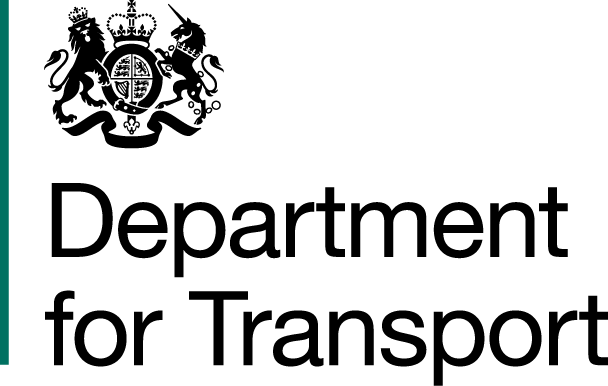Default 20mph speed limit on restricted roads | National monitoring report (September 2023 - April 2024)
Default 20mph speed limit on restricted roads
National monitoring report (September 2023 - April 2024)
Revision Final
Issue Date 26 September 2024
Executive summary
The new 20mph default speed limit was implemented on restricted roads across Wales on 17 September 2023. This report reviews data for monitoring the effects of the new default speed limit up to April 2024.
The new default speed limit is intended to promote the safety and well-being of people in Wales by reducing the likelihood and severity of road collisions and encouraging walking, wheeling and cycling. It is also expected to contribute to increased social interaction, stronger communities and improved mental and physical health.
This report assesses changes in key performance indicators (KPIs) set out in the 20mph National Monitoring Framework.¹ It covers KPIs on vehicle speeds, journey times and journey time reliability, interactions between pedestrians and vehicles at pedestrian crossings and air quality. The most recent data for these indicators was collected between September 2023 and April 2024.
Some KPIs are not covered in this monitoring report as they require data over a longer time period to make a meaningful assessment. These include casualty rates for pedestrians and cyclists, changes in public attitudes to the 20mph limit and estimated changes in carbon dioxide emissions.
Table 1 summarises the results for each of the KPIs reviewed. These are described in more detail in the body of this report.
- Vehicle speeds on 20mph main through roads have fallen by an average of 4.3mph, with reductions evident soon after the new limit was introduced. 58% of vehicles are now being driven at or below 24mph, compared to 20% before. These reductions are expected to lower the collision risk and the severity of resulting injuries.
- Average journey times have increased on most routes assessed but generally not by more than 2 minutes.² Simultaneously, journey time variability has reduced on most routes, indicating improved journey time reliability and meaning greater certainty on how long it will take to drive a particular route.
- Monitoring of vehicle and pedestrian interactions at pedestrian crossings has not revealed any clear impacts of the speed limit policy as yet, with changes in yielding behaviours varying between the sites assessed.
- Air quality monitoring in the phase 1 areas until April 2024 did not reveal any material difference in nitrogen dioxide concentrations between areas inside and outside the 20mph limit.
¹ Transport for Wales, Default 20mph speed limit on restricted roads: Monitoring Framework Document, 2023
² The routes assessed range from 5km to 61km in length. Further detail is provided in the main body of the report.
Table 1: KPI assessment summary (as of April 2024)
|
KPI |
KPI description | Assessment | Effect³ |
|---|---|---|---|
| 1.1 | Percentage travelling at or below 24mph (as a proxy for compliance with the 20mph speed limit) | Increase from 20% (pre-implementation) to 58% travelling at or below 24mph |
Strongly positive |
| 1.2 | Change in 85th percentile speed | 3.9mph reduction in speed |
Strongly positive |
| 1.3 | Change in mean speed | 4.3mph reduction in speed |
Strongly positive |
| 1.4 | Vehicle journey times and journey time variability, based on the difference between the 5th and 95th percentile journey times as a proxy for journey time reliability, on main through routes |
Marginal increase in average journey times. Marginal decrease in journey time variability (i.e. there is improved journey time reliability). |
Slightly negative Slightly positive |
| 3.2 | Change in vehicle and pedestrian yielding behaviours | Inconclusive at this stage, as the changes in yielding behaviours varied between the sites assessed. |
No discernible change |
| 4.1 | Change in local air quality - NO2 | No material effect identified |
No discernible change |
Comparisons between the results in Table 1 and the phase 1 monitoring results (where 20mph limits were introduced in 2021-22, in advance of the national roll-out) are included in this report.
³ Where a change is described as a positive effect this is understood in the sense that the result is aligned to the objectives of the new 20mph default speed limit on restricted roads.
Total journey time and variability September 2024
1. Introduction
1.1 Background
The Welsh Government introduced a 20mph default speed limit on restricted roads across Wales on 17 September 2023. This is the first national policy of its kind in the UK and there has been keen public interest in its effects.
Transport for Wales (TfW) works with the Welsh Government and highway authorities to assess these effects by monitoring changes in a predefined list of key performance indicators (KPIs). These KPIs are set out in the national 20mph monitoring framework and are summarised in section 2 of this report.⁴
This report reviews the most recent available data for the monitoring framework KPIs. This data was collected at a range of locations and covers the period up to the end of April 2024. It includes the following sources:
- Vehicle speed monitoring data.
- Data on journey times and journey time reliability.
- Yielding analysis, using camera technology to assess interactions between pedestrians and vehicles at crossings in 20mph areas.
- 20mph Phase 1: Air Quality Monitoring Report.⁵
Where equivalent data is available, comparisons are made with data collected to assess the effects of the 20mph limit for the eight phase 1 areas. In these phase 1 areas, 20mph speed limits were introduced in 2021/22, before the national roll-out.
1.2 Rationale for intervention
Reducing traffic speeds is intended to benefit communities and promote the safety and well-being of people in Wales. Introducing a lower speed limit is expected to reduce the likelihood and severity of collisions on the roads, with fewer pedestrians and cyclists being seriously or fatally injured. The reduced speed limit also aims to support the Welsh Government’s vision for walking, wheeling and cycling to be the natural mode of choice for short everyday journeys.⁶
⁴ Transport for Wales, Default 20mph speed limit on restricted roads: Monitoring Framework Document, 2023
⁵ Summary and full air quality reports are published at https://tfw.wales/about-us/transparency/publications/default-20mph-speed-limit
⁶ This vision is set out in the Active Travel Act Guidance (July 2021).
By reducing the number of injuries and fatalities on roads and reducing the negative effects of car use on the wider environment, the change to 20mph is anticipated to have further wide-reaching benefits. These include:
- More people choosing to walk, wheel or cycle (active travel), reducing the number of short distance car journeys in built-up areas.
- Increased social interaction within and across communities, helping to improve social cohesion.
- Improved physical and mental health outcomes due to increased physical activity and greater social interaction.
- Reduced NHS and taxpayer costs and reduced NHS workload due to fewer road collisions (and reduced severity of injuries and trauma).
- Reduced NHS costs resulting from the improved physical and mental health brought about by increased active travel.
- Strengthened local economies in areas previously affected by traffic speed issues, as a result of increased footfall and therefore increased retail and hospitality sector activity.
- Contribution to the aims of the Well-Being of Future Generations (Wales) Act 2015, in particular to ‘enable places to support the health and well-being of people and communities’ within the ‘healthier Wales’ goal.
While these wide-reaching benefits are anticipated, they cannot easily be measured and attributed to a single policy intervention. This is because there are a broad range of other influencing factors, including other Welsh Government interventions that aim to achieve similar benefits.
Nonetheless, the KPIs set out in the 20mph monitoring framework provide a means for assessing specific immediate effects from the policy and therefore an indication of whether the policy is likely to be contributing to wider societal benefits. These objectives and KPIs are described in more detail in section 2.
2. Objectives and key performance indicators
2.1 Monitoring framework overview
The national 20mph monitoring framework, published in September 2023, sets out three core objectives for implementing 20mph as the default speed limit on restricted roads:
- Reduce injury and death.
- Encourage a change in travel behaviour.
- Reduce negative effects of vehicle use on the wider environment.
The three core objectives are linked to five specific measurable objectives for 20mph speed limit implementation (see Figure 1). These objectives are:
- Reduce the number of pedestrians and cyclists killed or seriously injured on the road network.
- Encourage mode shift from private car to walking and cycling for shorter journeys in built-up areas.
- Reduce motor vehicle dominance in vehicle and pedestrian interactions.
- Reduce carbon emissions from transport as a result of mode shift from private car to walking, wheeling and cycling for shorter journeys in built-up areas.
- Maintain or improve local air quality due to smoother traffic speeds with less acceleration and deceleration.
Figure 1: Objectives of the default 20mph speed limit
|
Policy measure: Reduce default speed limit on restricted roads to 20mph |
||
|---|---|---|
|
Improve the well being of people in Wales |
Reduce injury and death |
Reduce the number of pedestrians and cyclists killed or seriously injured on the road network |
| Encourage a change in travel behaviour |
Encourage mode shift from private car to walking and cycling for shorter journeys in built-up areas |
|
|
Reduce motor vehicle dominance in vehicle and pedestrian interactions |
||
| Reduce negative effects of vehicle use on the wider environment |
Reduce carbon emissions from transport |
|
|
Maintain or improve local air quality |
||
Monitoring progress towards these objectives is undertaken by assessing 12 KPIs, as set out in Figure 2.
Figure 2: KPIs for assessing the effects of the default 20mph speed limit implementation
|
Objectives |
Key performance indicators (KPIs) | ||
|---|---|---|---|
|
1.1: Traffic compliance with 20mph speed |
1.2: Change in 85th percentile speed | 1.3: Change in mean speed | |
|
1.4: Vehicle journey times and journey time variation on main through routes (difference between 5th and 95th percentile journey times) |
|||
|
Reduce the number of pedestrians and cyclists killed or seriously injured on the road network |
2.1: Casualty rate for child pedestrians (aged 5-11 years), by sex and deprivation fifth, also by sex and urban/rural |
2.3: Casualty rate for older pedestrians and cyclists (aged over 75 years), by sex and deprivation fifth, also by sex and urban/rural |
|
|
2.2: Casualty rate for pedestrians and cyclists aged 12-74, by sex and deprivation fifth, also by sex and urban/rural |
|||
|
Encourage mode shift from private car to walking and cycling Reduce motor vehicle dominance in vehicle and pedestrian interactions |
3.1: Change in attitude to active travel use in built-up areas |
3.2: Change in vehicle and pedestrian yielding behaviours | |
|
Reduce carbon emissions from transport |
4.1: Change in local air quality - NO2 | 4.2: Change in CO2 emissions | |
|
5.1: Change in public attitudes to 20mph speed limits |
|||
2.2 National roll-out monitoring
Based on data collected up to April 2024, the following six KPIs are assessed in this report:
- Traffic compliance with the 20mph speed limit (KPI 1.1). This uses the percentage of vehicles travelling at or below 24mph as a proxy for compliance.⁷
- Change in 85th percentile speed (KPI 1.2).⁸
- Change in mean speed (KPI 1.3).
- Vehicle journey times and journey time variation on main through routes (KPI 1.4). This uses the difference between the 5th percentile and 95th percentile journey times as a proxy for journey time reliability.
- Change in vehicle and pedestrian yielding behaviours (KPI 3.2).
- Change in local air quality based on nitrogen dioxide (NO2) concentrations (KPI 4.1).
New data following the national roll-out of the 20mph speed limit have not yet been collated to report on the other six KPIs, for the following reasons:
- Casualty rates for pedestrians and cyclists (KPIs 2.1, 2.2, 2.3). At least three years’ worth of collision data will be required post implementation to allow for meaningful comparisons with at least a three-year pre-implementation period. It is therefore too early to report against these indicators.
- Change in attitude to active travel use in built-up areas (KPI 3.1). This KPI was initially assessed in 2022 through bespoke research commissioned by the Welsh Government on active travel use for journeys to primary schools. This research has not been repeated so no new data is available. However, a summary of the 2022 results is provided in this report for reference.
- Change in carbon dioxide (CO2) emissions (KPI 4.2). This will involve analyses undertaken over a longer time period.
- Change in public attitudes to 20mph speed limits (KPI 5.1). This KPI will consider perceptions of traffic speeds, traffic noise and effects on communities and will be assessed through future research.
Table 14 in Annex C outlines the timescales and source locations for the monitoring data and indicates which sites were used for phase 1 and which are new for the national monitoring programme.
⁷ For reasons explained in section 3.1, vehicles travelling at 24mph or under are considered to be compliant with the speed limit.
⁸ The speed at which 85% of drivers drive at or below under free-flowing conditions.
3. Monitoring results
3.1 Traffic speeds
Locations and method
Traffic speed monitoring devices were installed at 44 locations across 10 areas. They provided data for the following KPIs:
- Traffic compliance with the 20mph speed limit (KPI 1.1)
- Change in 85th percentile speed (KPI 1.2)⁹
- Change in mean speed (KPI 1.3).
Table 2 provides a summary of speed monitoring locations. Maps showing specific locations are included in Annex A.
Data was collected using monitoring devices installed across the carriageway on main through roads in each area. All roads monitored had a 30mph speed limit before 17 September 2023 and a 20mph speed limit afterwards. At the time of monitoring, all the roads were largely free from roadworks and other physical restrictions that could reduce traffic speed.
Pre-implementation speed data was collected over four weeks during July and early September 2023. In the Torfaen area (Cwmbran, Pontypool and Blaenavon), a shorter period of data collection took place over one week in early 2023.
Post-implementation speeds are based on four weeks of data collected between November 2023 and January 2024, excluding the Christmas and new year period.
Table 2: Summary of speed monitoring device locations and data availability
|
Area |
Number of speed monitoring locations |
|---|---|
| Lampeter |
4 |
| Penrhyn Bay |
4 |
| Llanrug |
3 |
| Allt-yr-yn (Newport) |
3 |
| Pembroke Dock |
3 |
| Newtown |
4 |
| Tylorstown/Pontygwaith |
4 |
| Torfaen (Cwmbran, Pontypool and Blaenavon) |
8 |
| Wrexham |
10 |
| Peniel |
1 |
The speed at which 85% of drivers drive at or below, under free-flowing conditions.⁹
Changes in the mean and 85th percentile speeds within each area are weighted by traffic flows on each road.
Traffic speed monitoring devices record exact vehicle speeds and then categorise speeds for analysis within 5mph bands, for instance 15-19mph inclusive or 20 24mph. For KPI 1.1, anyone driving at or below 24mph is assumed to be broadly compliant with the new speed limit - this matches one of the thresholds typically used for enforcement.
Headline data
Table 3 presents headline KPI assessments for traffic speeds based on data collected between July 2023 and January 2024. The most recent four weeks of post-implementation data (from November 2023 to January 2024, excluding the Christmas and new year period) has been compared to the four weeks of pre-implementation data (July and September 2023).
Table 3: Traffic speeds KPI assessments (national roll-out)
|
KPI |
Pre-implementation | Post-implementation | Change |
|---|---|---|---|
|
1.1 Percentage travelling at or below 24mph (as a proxy for compliance with the 20mph speed limit) |
20% | 58% | 38 percentage point increase |
|
1.2 Change in 85th percentile speed |
33.1mph | 29.2mph | 3.9mph reduction |
|
1.3 Change in mean speed |
28.9mph | 24.6mph | 4.3mph reduction |
Any speed reduction is a positive step towards achieving the wider well-being benefit, given that it reduces both the likelihood of collisions and the severity of resulting injuries.¹⁰
¹⁰ An earlier study found that every 1mph reduction in urban mean speeds is shown to reduce the frequency of collisions by between 2% and 7%. Source: Taylor, M., Lynam, D., Baruya, A (2000) The effects of drivers’ speed on the frequency of road accidents, Crowthorne: TRL
Traffic speed comparisons with phase 1 findings
Speed monitoring for the same KPIs was also carried out in phase 1 of implementing the 20mph limit (2021/22), at different monitoring locations.¹¹ The results for this are presented in Table 4.
The results for both the national implementation and phase 1 show a general reduction in traffic speeds. The reduction in 85th percentile speeds and mean speeds were smaller for phase 1 than for the national implementation. However, it is notable that the pre-implementation 85th percentile and mean speeds were already lower in the phase 1 areas compared to those on the roads being monitored for the national monitoring programme.
Table 4: Traffic speeds KPI assessments (phase 1 for comparison purposes only)
|
KPI |
Pre-implementation | Post-implementation | Change (Phase 1 only) |
|---|---|---|---|
|
1.1 Percentage travelling at or below 24mph (as a proxy for compliance with the 20mph speed limit) |
50% | 65% | 15 percentage point increase |
|
1.2 Change in 85th percentile speed |
29.6mph | 26.6mph | 3.0 mph reduction |
|
1.3 Change in mean speed |
25.2mph | 23.6mph | 1.6 mph reduction |
¹¹ Phase 1 data was obtained at the following sites: Abergavenny, Buckley, Cardiff (North), Cilfrew, Llanelli (North),Severnside (Caerwent, Caldicot, Magor, Undy), St Brides Major, St Dogmaels, see https://tfw.wales/sites/default/files/2024-02/Phase-1-20mph-Final-Monitoring-Report.pdf
Speed limit compliance (KPI 1.1)
For this KPI, anyone driving at or below 24mph is considered to be compliant with the new speed limit. Figure 3 shows the change in the proportion of vehicles travelling at or below 24mph within each area. The overall weighted mean is weighted by traffic flow within each area.
Overall, the proportion of vehicles travelling at or below 24mph increased from 20% pre-implementation to 58% as an average across all monitored sites post-implementation. The largest change was observed in Peniel, an increase of 60 percentage points, from 10% to 70% travelling at or below 24mph. The smallest change was in Tylorstown/Pontygwaith, with an increase of 19 percentage points travelling at or below 24mph.
Figure 3: Percentage of vehicles travelling at or below 24mph
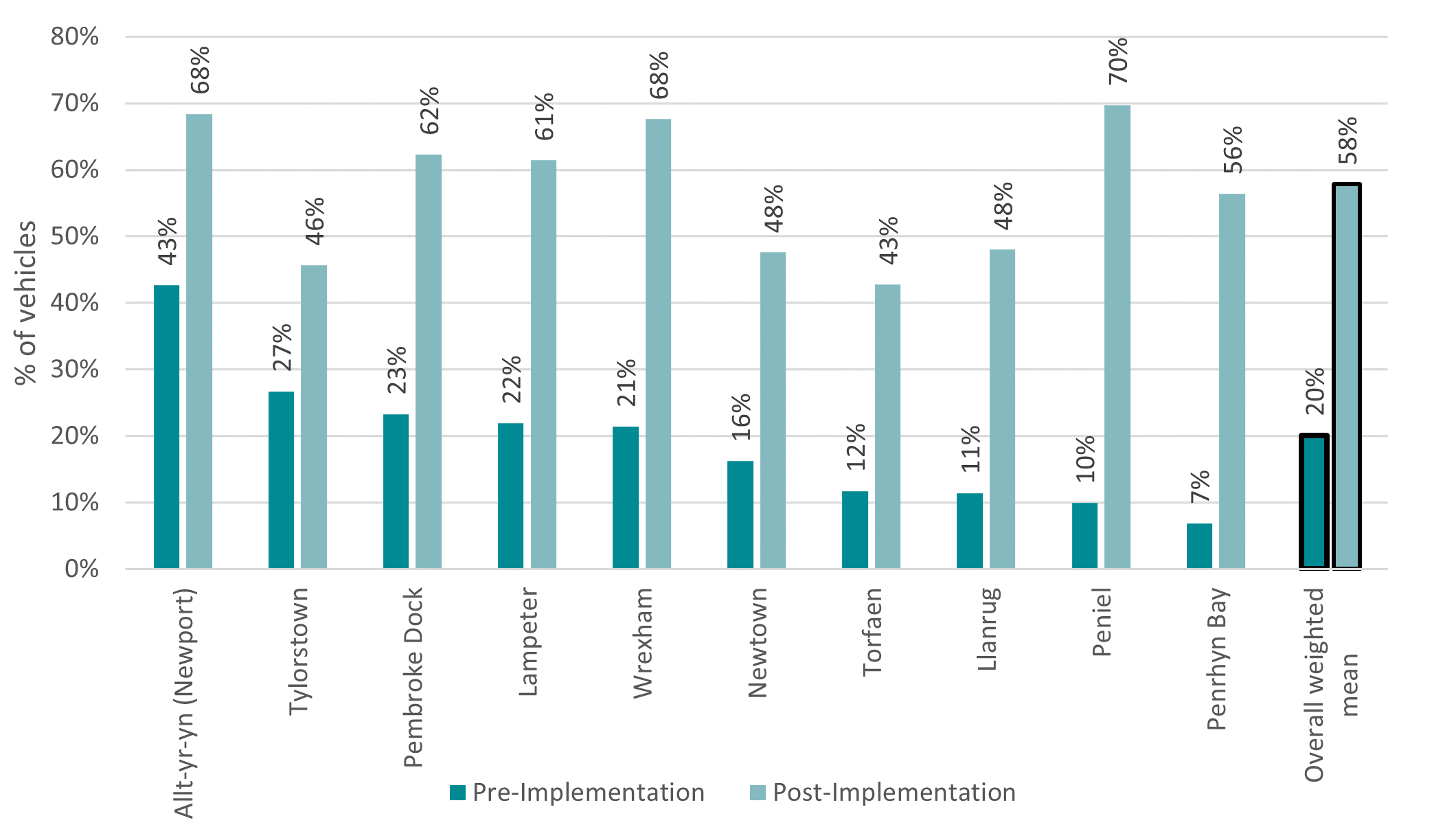
Speed distributions
Figure 4 compares the percentage of drivers in different speed bands from pre- to post-implementation.
The proportion of vehicles driving between 20-24mph increased from 15% to 39%.
The proportion of vehicles driving over 24mph fell from 80% to 43%.
All of these changes reflect a general slowing down of traffic speeds, even among those drivers driving substantially over the speed limit. Following the introduction of the national 20mph speed limit, the percentage of vehicles travelling over 35mph fell from 12% to 4%.
Figure 4: Proportion of vehicles travelling in different speed brackets
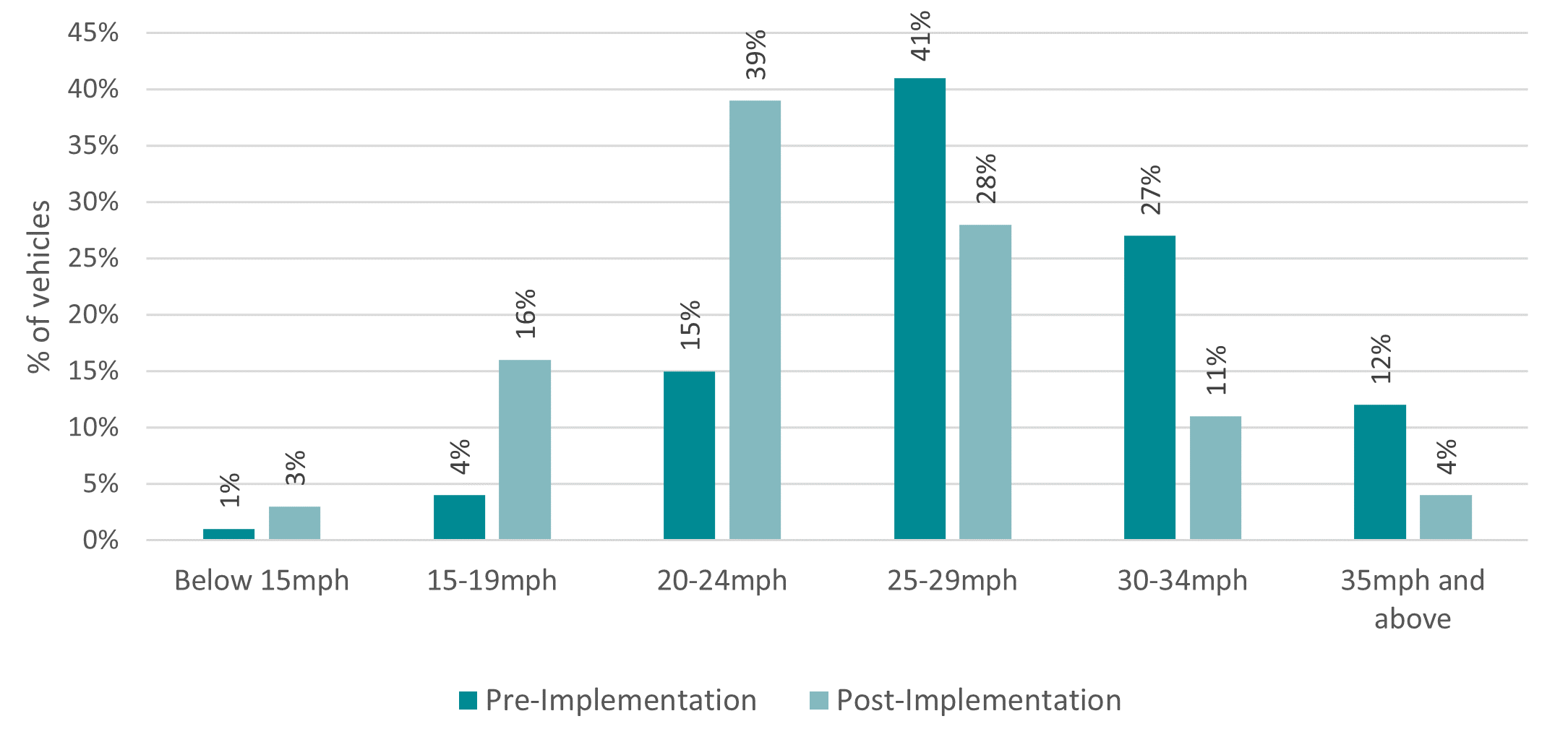
85th percentile speeds (KPI 1.2)
This KPI measures the speed at which 85% of the observed vehicles are travelling at or below. It is a standard measure used in evaluating speed limits and provides a measure of the highest speed the majority of drivers are using on a particular road. Unlike the mean speed measure, it is unaffected by any extremely high speeds well above the speed limit by a small proportion of drivers.
Comparing pre- and post-implementation data, 85th percentile speeds reduced in all areas, as illustrated in Figure 5 which shows that:
- 85th percentile speeds have reduced by an average of 3.9mph.
- The largest reductions in 85th percentile speeds were observed in Peniel (-6.4mph), Lampeter (-5.1mph) and Penrhyn Bay (-4.9mph).
- The smallest reduction was in Tylorstown/Pontygwaith (-2.6mph).
Figure 5: 85th percentile speeds, pre- and post-implementation
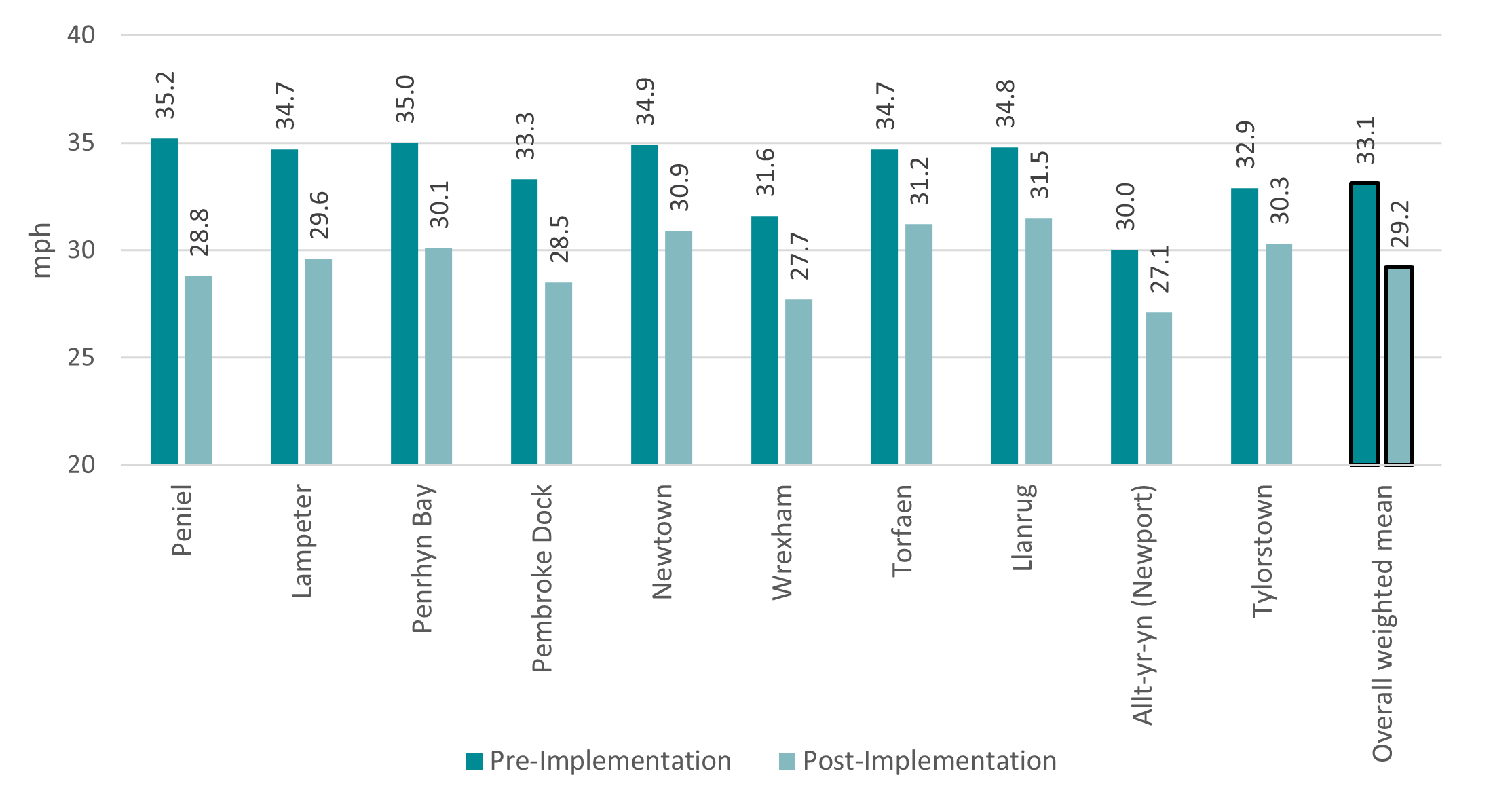
Mean speeds (KPI 1.3)
Figure 6 shows a comparison between pre- and post-implementation mean speeds (July/September 2023 versus November 2023 and January 2024).
Speeds fell after introducing the 20mph limit by 4.3mph on average. The largest falls were at Peniel (- 7.1mph), Penrhyn Bay (-5.2mph) and Lampeter (-5.1mph). The smallest change in mean speeds was at Tylorstown/Pontygwaith (-2.9mph).
Figure 6: Mean speeds, pre- and post-implementation
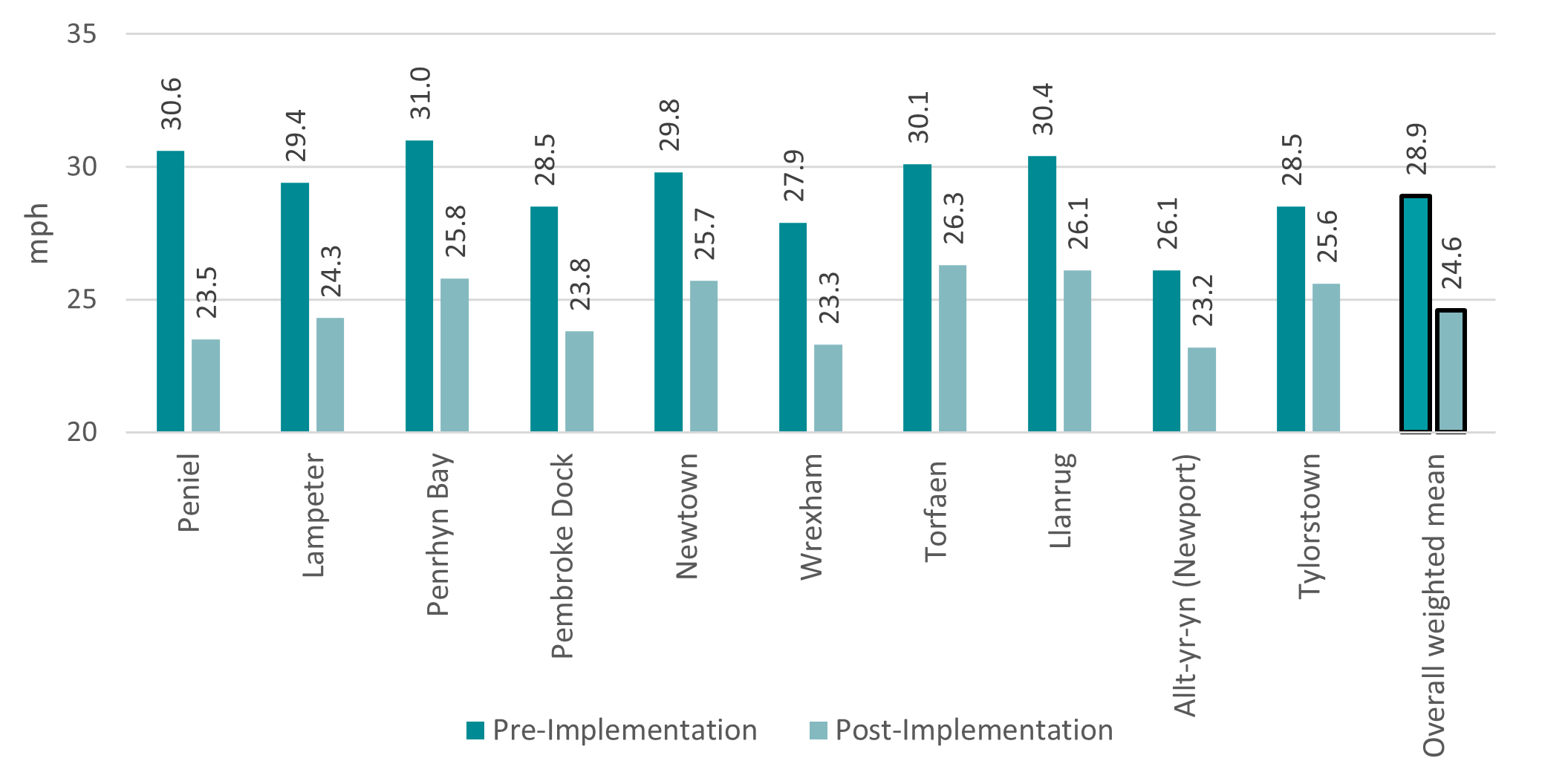
Traffic speed trends
Figure 7 and Table 5 confirm that average speeds declined in all ten monitoring areas immediately after the 20mph speed limit national roll-out in September 2023. After this the average speeds continued to decline slightly in five of the ten monitoring areas but increased slightly in the five other areas.
Figure 7: Trends in mean speeds, July 2023 to January 2024
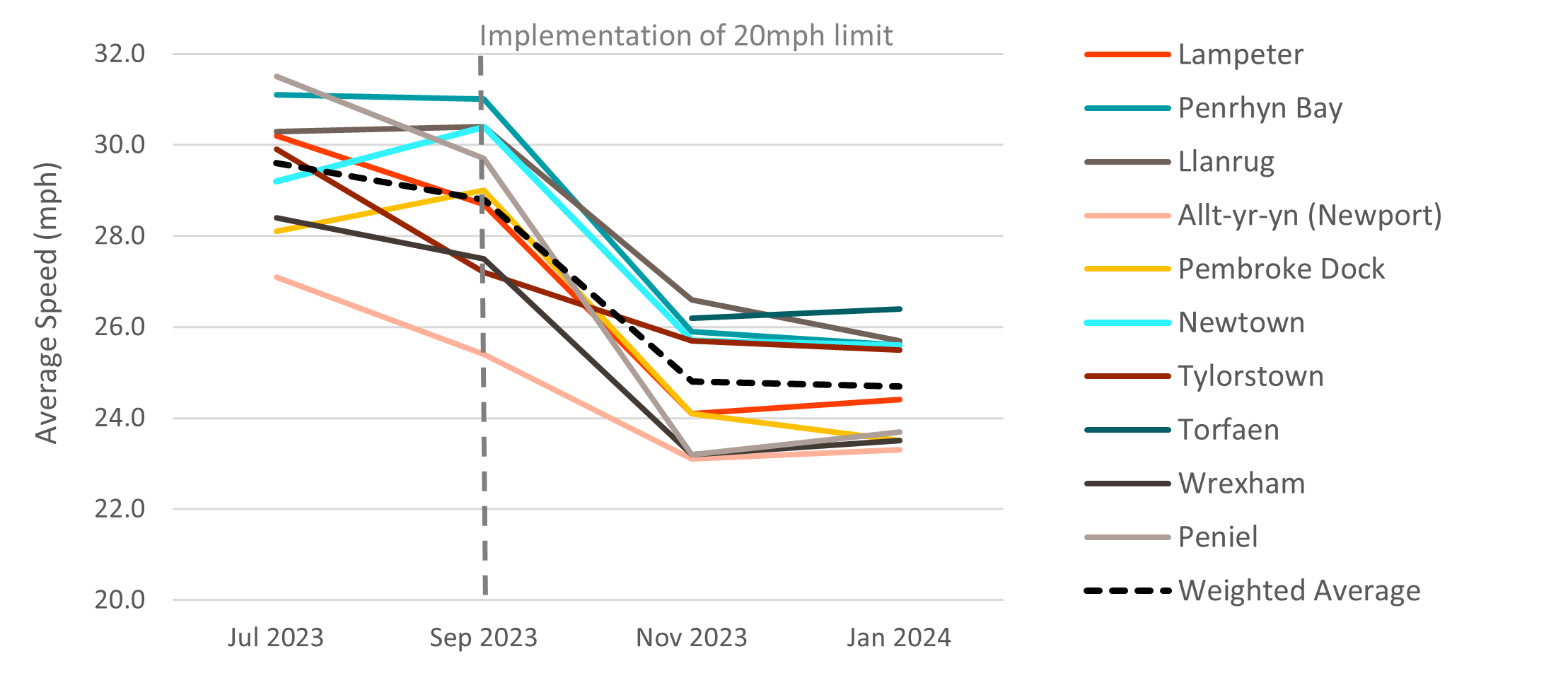
Table 5: Trends in mean speeds, July 2023 to January 2024
| Area | Pre- Implementation | Pre Implementation | Post Implementation | Post Implementation |
| July 2023 (mph) | September 2023 (mph) | November 2023 (mph) | January 2024 (mph) | |
| Lampeter | 30.2 | 28.7 | 24.1 | 24.4 |
| Penrhyn Bay | 31.1 | 31.0 | 25.9 | 25.6 |
| Llanrug | 30.3 | 30.4 | 26.6 | 25.7 |
| Allt-yr-yn (Newport) | 27.1 | 25.4 | 23.1 | 23.3 |
| Pembroke Dock | 28.1 | 29.0 | 24.1 | 23.5 |
| Newtown | 29.2 | 30.4 | 25.7 | 25.6 |
| Tylorstown | 29.9 | 27.2 | 25.7 | 25.5 |
| Torfaen | 30.1 | * | 26.2 | 26.4 |
| Wrexham | 28.4 | 27.5 | 23.2 | 23.5 |
| Peniel | 31.5 | 29.7 | 23.2 | 23.7 |
| Overall weighted mean | 30.5 | * | 24.6 | 24.6 |
*Data not available for the Torfaen area
3.2 Journey time reliability
Headline data
Table 6: Journey times and journey time variability KPI assessment
|
KPI |
KPI description | Assessment |
|---|---|---|
|
1.4 |
Vehicle journey times and journey time variation on main through routes | Overall, there has been a marginal increase in average journey times and a marginal decrease in journey time variability (meaning that there is improved journey time reliability) |
Locations and method
Anonymised in-vehicle telematics data collected by INRIX has been used to assess journey times and journey time reliability on fifteen routes, as presented in Table 7 and shown in Annex B.
The routes were selected to represent a broad range of different types and lengths of routes including inter-urban rural routes, short urban routes, routes to out-of-town destinations, commuter and school routes.
The data was collected in both directions on each route and for morning and evening peak periods, so that there are four pre-implementation average journey times and four post-implementation average journey times for each route. This provides a total of 60 data points across the routes, which is set out in full in Table 15 in Annex C.
Pre-implementation data was taken from the February to April 2023 period and post-implementation data from February to April 2024. Data was taken from Tuesdays, Wednesdays and Thursdays to avoid public holidays around Easter affecting like-for-like comparisons.
Table 7: Routes used for journey time assessment
|
Route |
Direction | Route description | Distance (km) |
|---|---|---|---|
| 1 | A | Aberystwyth to Cardigan | 61 |
| B | Cardigan to Aberystwyth | 61 | |
| 2 | A | Llandudno to Betws-y-coed | 29 |
| B | Betws-y-coed to Llandudno | 29 | |
| 3 | A | Carmarthen to Coleg Sir Gar | 27 |
| B | Coleg Sir Gar to Carmarthen | 27 | |
| 4 | A | Porthmadog to Caernarfon | 32 |
| B | Caernarfon to Porthmadog | 32 | |
| 5 | A | Caerphilly to Newport | 18 |
| B | Newport to Caerphilly | 18 | |
| 6 | A | Wrexham to Deeside (Shotton) | 20 |
| B | Deeside (Shotton) to Wrexham | 20 | |
| 7 | A | St Davids to Haverfordwest | 25 |
| B | Haverfordwest to St Davids | 25 | |
| 8 | A | Ystrad Mynach to Crosskeys | 12 |
| B | Crosskeys to Ystrad Mynach | 12 | |
| 9 | A | Sketty to Morriston Hospital | 9 |
| B | Morriston Hospital to Sketty | 9 | |
| 10 | A | Pontypool to Blaenavon | 11 |
| B | Blaenavon to Pontypool | 11 | |
| 11 | A | Bangor-on-Dee to Wrexham Maelor Hospital | 10 |
| B | Wrexham Maelor Hospital to Bangor-on-Dee | 10 | |
| 12 | A | Barry Hospital to Dinas Powys | 8 |
| B | Dinas Powys to Barry Hospital | 8 | |
| 13 | A | St Asaph to Denbigh | 9 |
| B | Denbigh to St Asaph | 9 | |
| 14 | A | Treforest to Nantgarw | 7 |
| B | Nantgarw to Treforest | 7 | |
| 15 | A | Coedpoeth to Wrexham Maelor Hospital | 5 |
| B | Wrexham Maelor Hospital to Coedpoeth | 5 |
Monitoring results - journey times
Figure 8 presents the average journey times on the fifteen routes, by direction and time period (AM/PM), after the new 20mph default speed limit was introduced.
Figure 9 and Figure 10 show the absolute and relative change in journey times compared to the pre-implementation period.
The average journey time was calculated for both directions and time periods on each of the fifteen routes, so there are 60 data points in total.
- In most cases (55 out of 60), average journey times have increased. Of these, almost all have increased by less than 2 minutes. In over half of cases they have increased by less than 1 minute.
- In the majority of cases where average journey times increased (38 of the 55) they increased by less than 5%. In only 7 cases they increased by more than 8%.
- The most significant change in average journey time was a 3 minute increase on the Cardigan to Aberystwyth route in the evening peak period. However this is only a 5% increase in relative terms as this route is considerably longer than the others at 61km.
- The most significant change in relative terms was a 10% increase in journey time on the Blaenavon to Pontypool route (route number 10B) in the morning period.
Figure 8: Post-implementation average journey times by route¹²
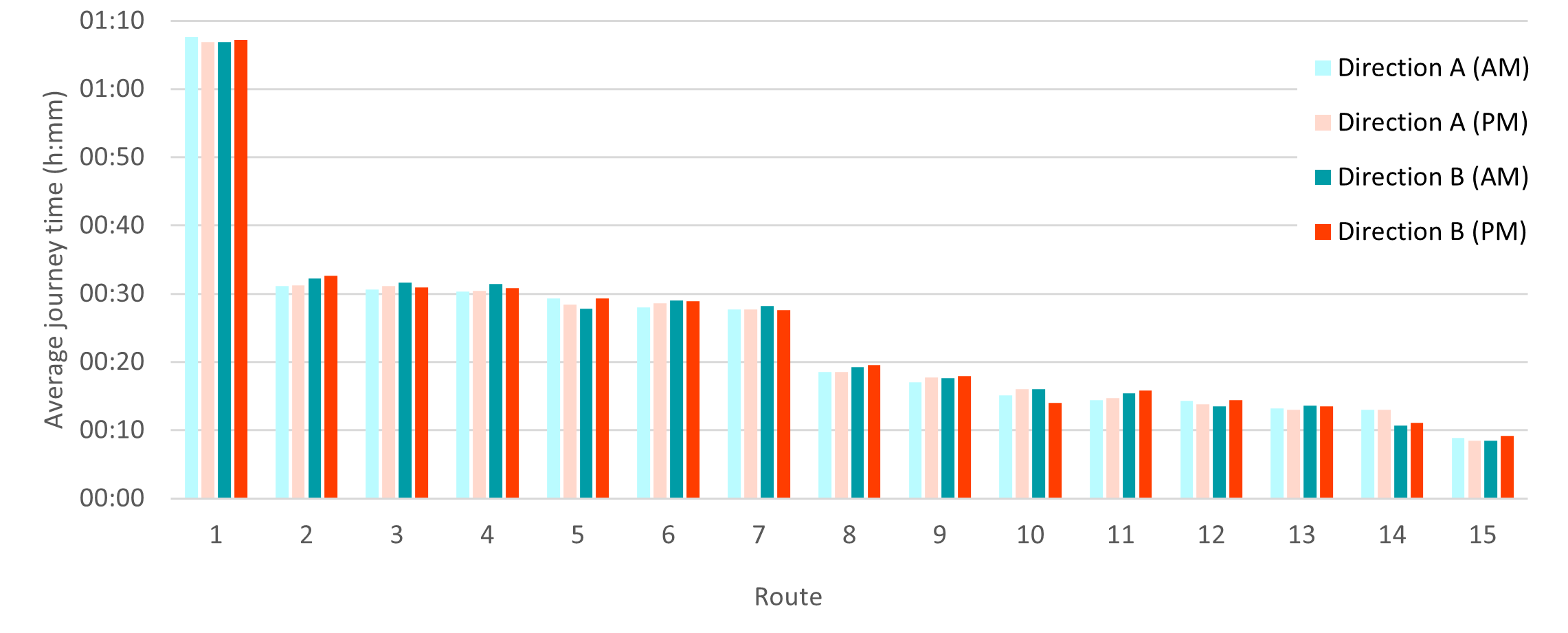
¹² Refer to Table 7 for the names of routes numbered 1-15 on the x axis. Annex B contains a map showing the route locations.
Figure 9: Change in average journey times (post- vs pre-implementation)
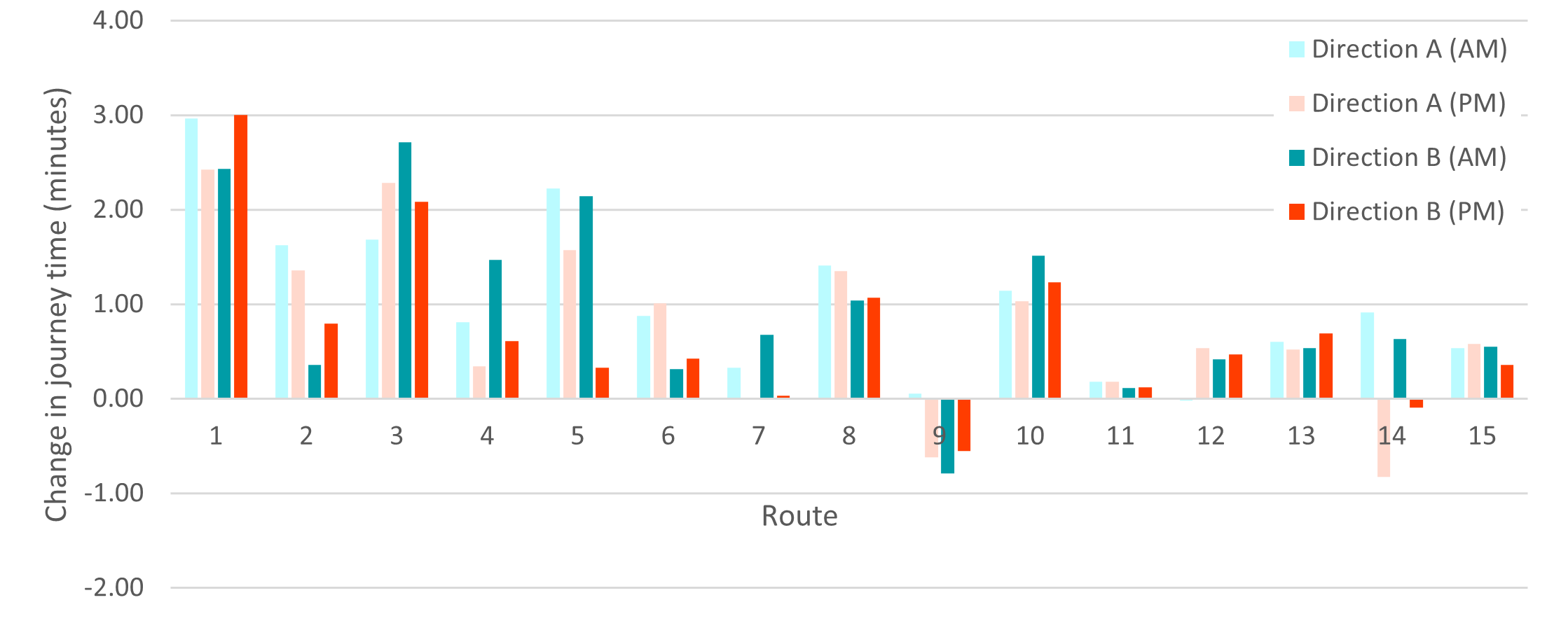
Figure 10: Percentage change in average journey times (post- vs pre-implementation)
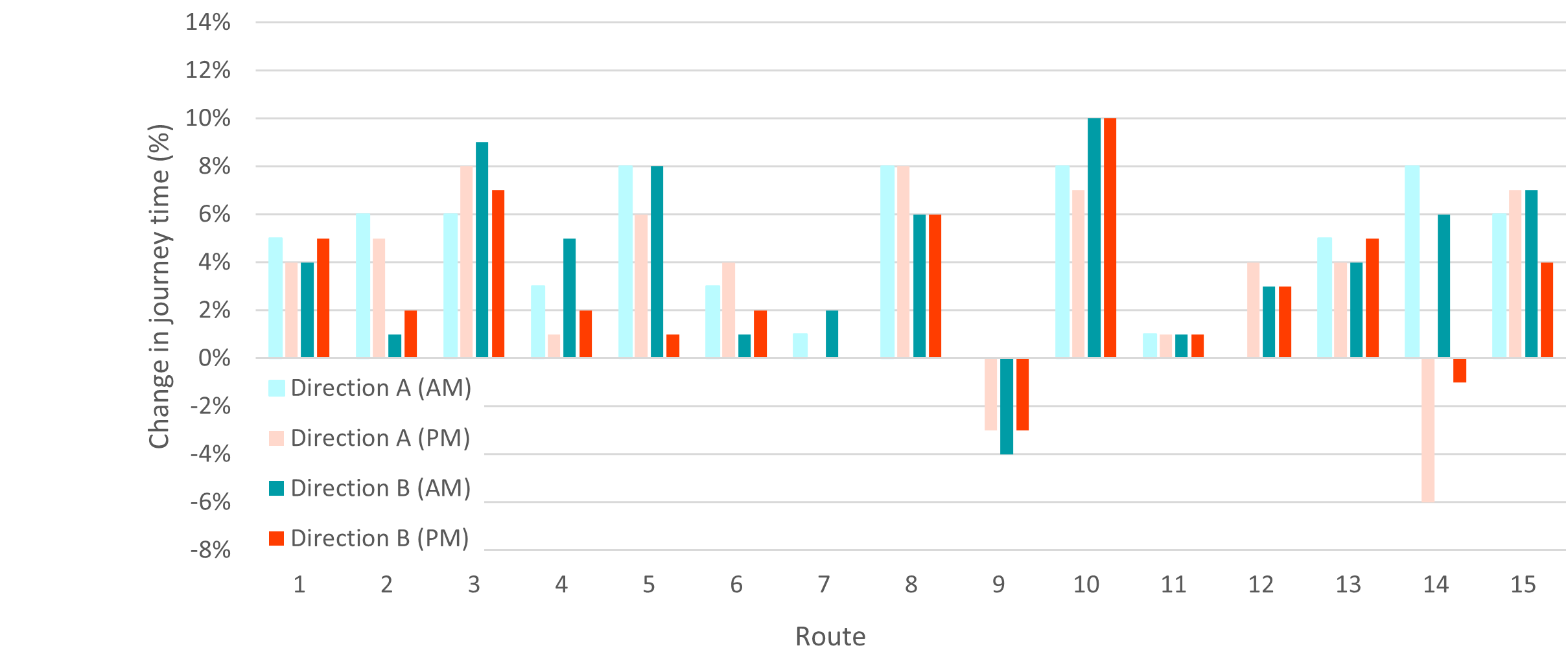
Monitoring results - journey time reliability
Journey time reliability is a measure of how predictable variations in journey time are for the person travelling. Unpredictable journey times are usually caused by traffic congestion. The same journey at the same time, but on different days, can take different lengths of time to complete.
Journey time variability has been included in the national monitoring framework as a KPI to assess whether the new default speed limit on restricted roads has led to any change in journey time reliability. For this KPI, reliability has been defined as the journey time range on a given route between the slowest 5% (the 5th percentile) and the fastest 5% (the 95th percentile) of all journeys.
Journey time reliability has been calculated for both directions and morning (AM) and evening (PM) time periods on each of the fifteen routes, so there are 60 data points in total.
Figure 11 shows the average journey time variability for the pre-implementation period on the left and the post-implementation period on the right. The bottom of each bar represents the 5th percentile journey time and the top represents the 95th percentile journey time. Therefore, the length of each bar represents the variability of journey times along that route. We can see that in many cases the whole bar has moved up, indicating a slight increase in the average journey time, but the length of the bar has decreased, meaning less journey time variability. This means that on most routes the journey times are slightly longer but more reliable, so that it is easier to predict how long the journey will take.
Figures 12 and 13 show the changes in average journey time variability in absolute terms (minutes) and relative changes (percentage).
Figure 11: Average journey time variability by bi-directional route and time period (AM and PM)¹³
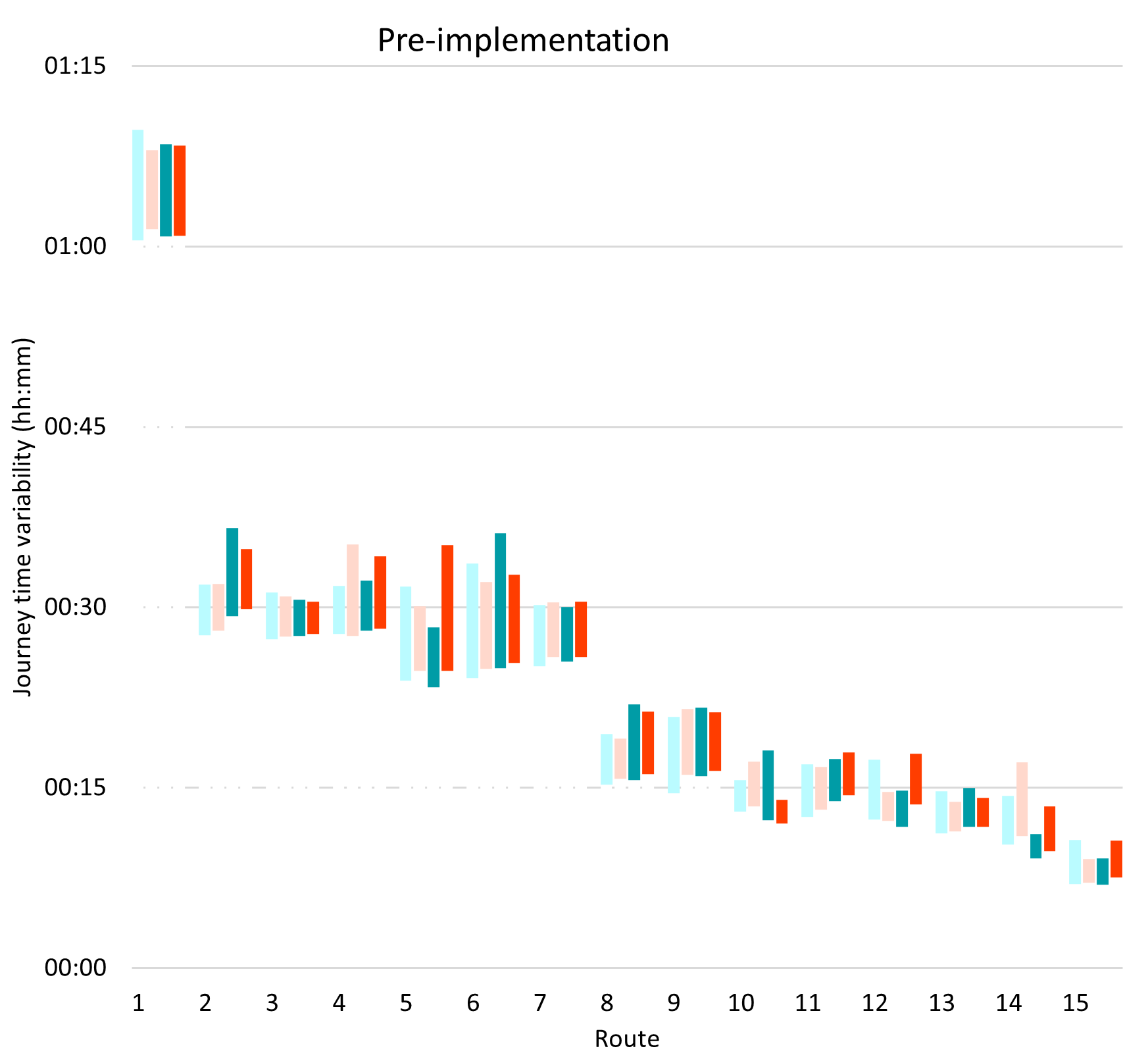
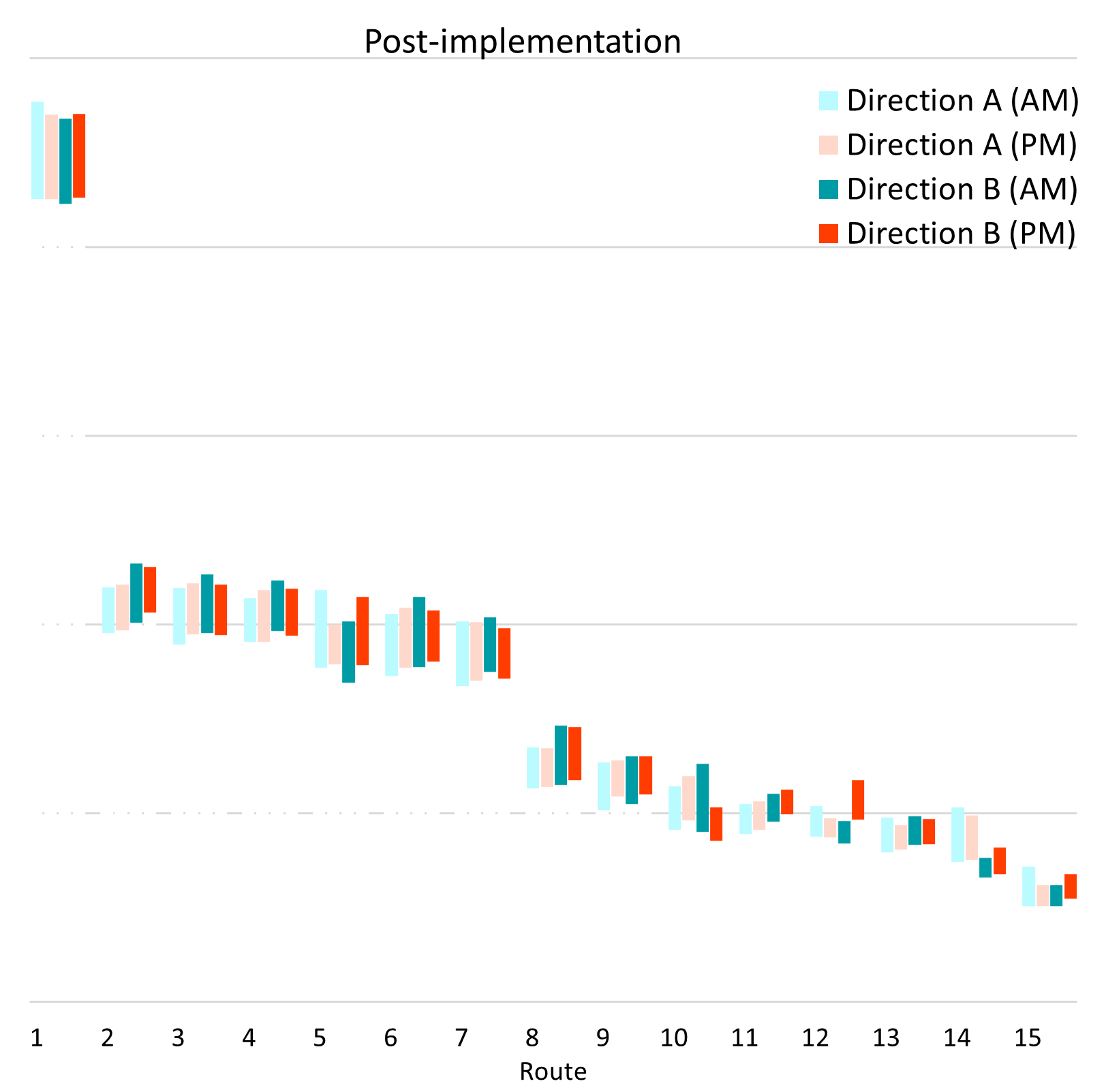
¹³ Refer to Table 7 for names of routes numbered 1-15 on the x axis. Route locations are shown in Annex B.
Figure 12: Absolute change in journey time variability (post- vs pre-implementation)¹⁴
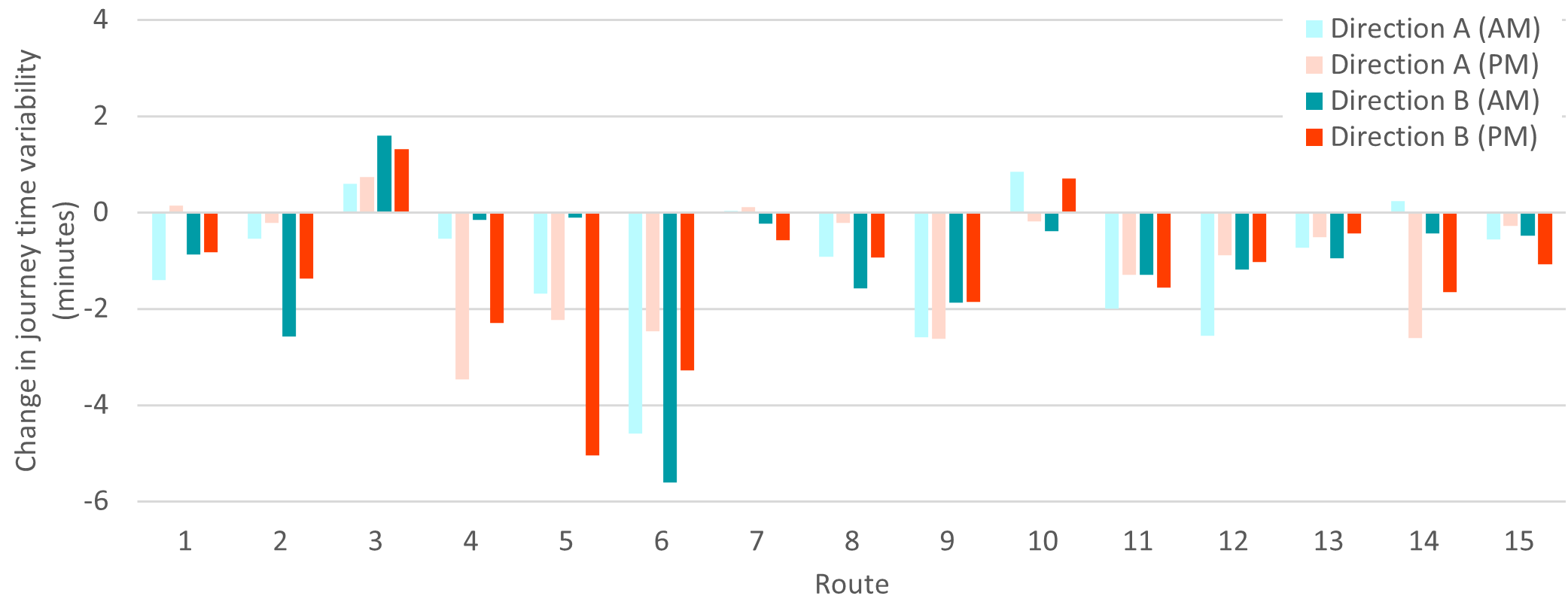
Figure 13: Relative change in journey time variability (post- vs pre-implementation)
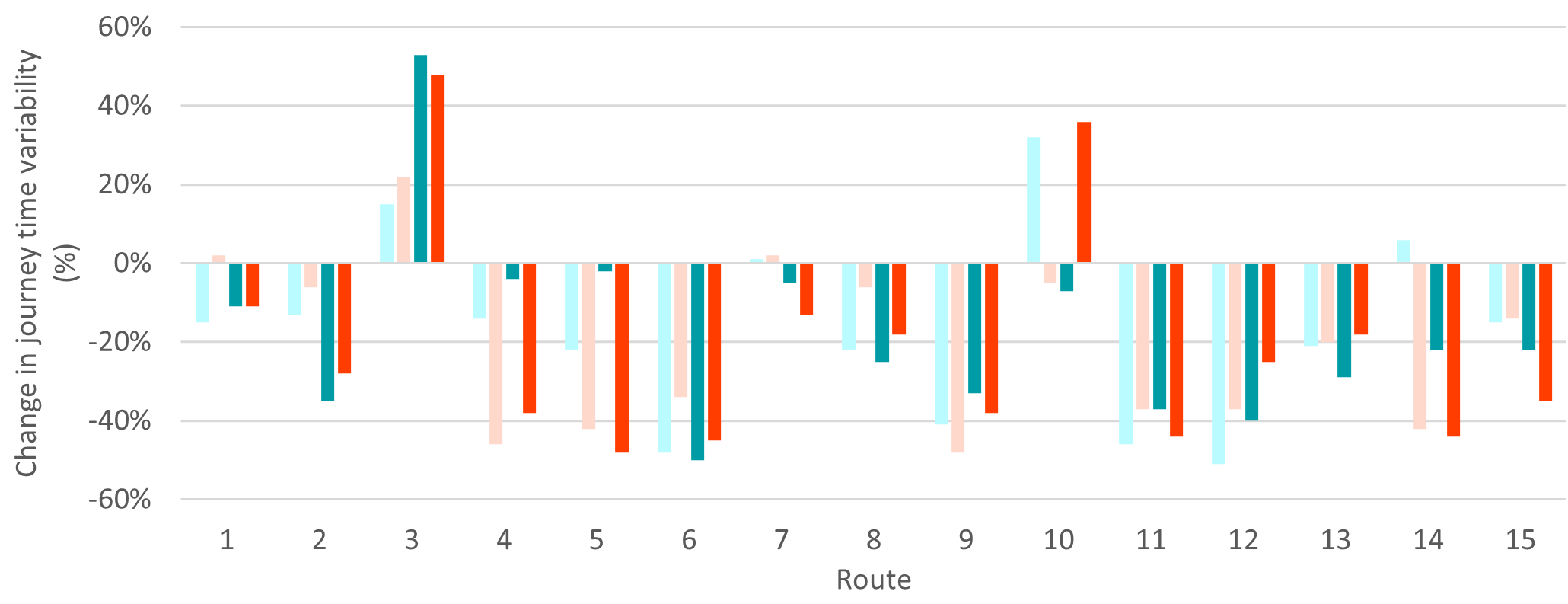
Overall, journey time reliability appears to have improved (reduced).
- In most cases (50 out of 60), the journey time variability has decreased.
- In almost half (27 out of 60), the journey time variability has decreased by more than 1 minute.
- In over half of cases (33 out of 60), the journey time variability has decreased by more than 20%. The largest decrease was 50% on the Deeside (Shotton) to Wrexham route in the morning period (-5:36 minutes).
- In a small number of cases (10 of the 60), journey time variability increased but in only two of these it increased by more than one minute, both on the Coleg Sir Gar to Carmarthen route (3B) which saw the largest increase of +1:36 minute (a 53% increase) in the morning period.
¹⁴ Refer to Table 7 for names of routes numbered 1-15 on the x axis. Route locations are shown in Annex B.
3.3 Changes in attitudes to active travel use in built-up areas
There is no new data available yet to track the KPI on attitudes to active travel. However, the results from the 2022 phase 1 research on this issue are included here for reference.
In 2021 the Welsh Government commissioned Living Streets to work with primary schools in the phase 1 20mph speed limit areas and in separate control areas (remaining at 30mph). The aim was to better understand travel behaviours and attitudes towards active travel (walking, wheeling and cycling).
Baseline surveys in the first part of the 2021/22 academic year indicated that 49% of children across the phase 1 and control areas either walked or cycled to school.
Surveys conducted later in the same academic year (between January and May, depending on the area) showed that active travel had increased among children in the phase 1 and control area schools. However, in the 20mph phase 1 schools the increase was from 49% to 74% (a 25 percentage point increase), compared to an increase from 49% to 67% (an 18 percentage point increase) in the control areas.
The sample size for the study was 3,036 children.
Table 8: Active travel KPI assessment
|
KPI |
KPI description | Assessment (November 2022) |
|---|---|---|
| 3.1 | Change in attitude to active travel use in built-up areas | 25 percentage point increase in active travel use on journeys to school in phase 1 20mph areas, compared to an 18 percentage point increase in 30mph control locations. |
3.4. Vehicle and pedestrian interactions
Headline data
Table 9 presents the headline KPI assessment for vehicle and pedestrian interactions based on data collected in three areas before and after implementation of the 20mph speed limit policy.
Table 9: Vehicle and pedestrian interaction KPI assessment
|
KPI |
KPI description | Assessment |
|---|---|---|
| 3.2 | Change in vehicle and pedestrian yielding behaviours | The results are inconclusive at this stage as the change in yielding behaviours varied between the sites assessed. |
Locations and method
Vehicle and pedestrian interaction assessments consider how drivers react in response to pedestrians intending to cross or already crossing the road. Transport for Wales commissioned VivaCity to install camera equipment to monitor vehicle and pedestrian interactions. Data has been processed for a pre-implementation period, when the speed limit was 30 mph (28 February – 31 March 2023) and a post implementation period, when the speed limit was 20 mph (19 February – 18 March 2024), at three pedestrian crossing locations:
- Gilwern - Crickhowell Road
- Queensferry - Station Road
- Cardiff Thornhill - Excalibur Drive (zebra crossing)
Sophisticated software linked to the cameras assigns observed interactions between vehicles and pedestrians to one of five separate categories:
- Vehicle slowed or stopped, to allow a pedestrian to cross.
- Vehicle maintained speed, despite pedestrian waiting at the crossing.
- Vehicle maintained speed, despite pedestrian already crossing the road.
- Vehicle sped up, despite pedestrian waiting at the crossing.
- Vehicle sped up, despite pedestrian already crossing the road.
Monitoring results - vehicle and pedestrian interactions
The monitoring results are shown in Table 10. Driver behaviour can vary significantly between different sites depending upon road layout and other factors as well as the speed limit. For example, before the speed limit change at the Gilwern site, over 70% of interactions involved a driver slowing or stopping at the crossing, whereas at the other two sites this was less than 20%. Therefore, the change in yielding behaviours since the introduction of the new speed limit has been assessed for each of the three sites separately.
In both monitoring periods, recorded instances of ‘maintained speed while pedestrian was in crossing’ does not necessarily indicate dangerous behaviour. It would depend on the vehicle speed and distance from the crossing and the exact location of the pedestrian.
The observed changes were small and varied between the sites making it difficult to draw any firm conclusions on the effect of the speed limit change on yielding behaviours.
At two of the three sites, there was a small increase in the proportion of interactions involving vehicles speeding up when approaching a crossing where a pedestrian was waiting. However, this was not seen at the Cardiff Thornhill site zebra crossing.
Table 10: Vehicle and pedestrian interactions
| Gilwern | Queensferry |
Cardiff |
|||||||
| 2023 | 2024 | Change | 2023 | 2024 | Change | 2023 | 2024 |
Change |
|
|
Slowed or stopped |
71% | 74% | +3% | 11% | 9% | -2% | 17% | 15% | -2% |
|
Maintained speed |
24% | 18% | -6% | 55% | 56% | -1% | 82% | 84% | +2% |
|
- pedestrian waiting |
21% |
13% |
-8% | 46% | 49% | -3% | 31% | 33% | +2% |
|
- pedestrian in crossing |
3% | 5% | +2% | 9% | 7% | -2% | 51% | 51% | - |
|
Sped up |
5% | 8% | +3% | 34% | 35% | +1% | 1% | 1% | - |
|
- pedestrian waiting |
5% | 7% | +2% | 29% | 32% | +3% | 1% | 1% | - |
|
- pedestrian in crossing |
0% | 1% | +1% | 5% | 3% | -2% | 1% | 1% | - |
Figure 14: Comparison of vehicle and pedestrian interactions
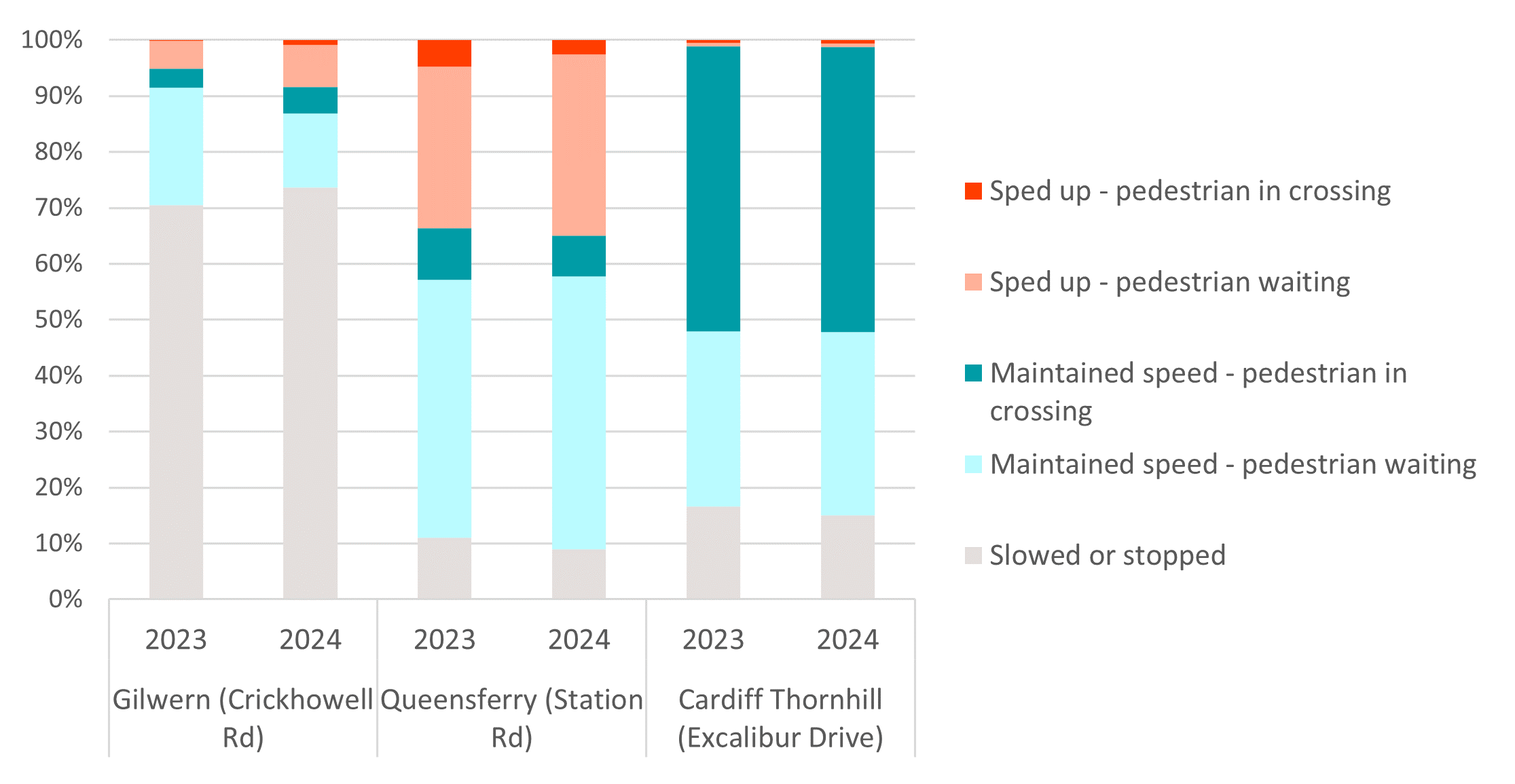
Comparisons with phase 1
For the phase 1 monitoring, vehicle and pedestrian interactions were analysed for three sites subject to a 20mph speed limit (Abergavenny, Buckley and Cardiff North) and three control locations where the speed limit was still 30mph (Gilwern, Queensferry and Cardiff Thornhill).
The total number of interactions for the three phase 1 20mph sites was compared with the total for the three 30mph sites during similar time periods in June 2022 and March 2023. This phase 1 assessment indicated that fewer vehicles were speeding up when approaching pedestrians crossing in a 20mph area compared with a 30mph area. However, as this is a comparison between different locations, we could not be confident about the extent to which any apparent difference in yielding behaviours is attributable to the speed limit change rather than other site-specific factors such as road layout and the type of crossing.
The latest data assessment (Table 10 and Figure 14) compares yielding data between different time periods (before and after implementation) at the same locations, which should allow a more robust assessment of the impacts of the policy over time.
Figure 15: Phase 1 comparison of vehicle and pedestrian interactions
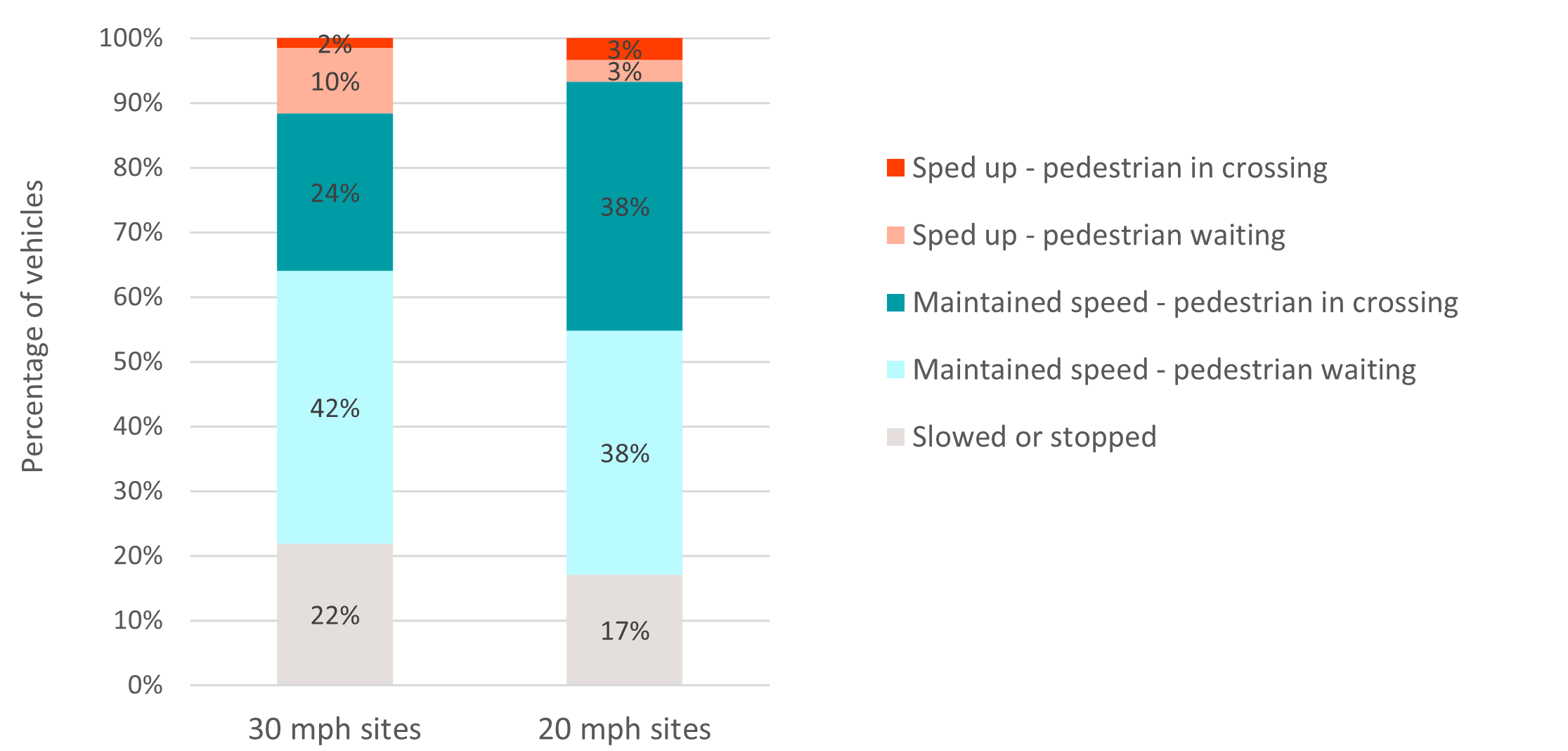
3.5 Air quality
Headline data
Table 11 presents the headline KPI assessment for air quality based on data from May 2022 to April 2024 collected in Abergavenny, Cardiff (North) and Magor (Severnside area). Speed limits were reduced in 2022 in all three areas as part of phase 1 of the 20mph programme.
Table 11: Air quality KPI assessment
|
KPI |
KPI description | Assessment |
|---|---|---|
| 4.1 | Change in local air quality - NO2 | No materially significant effect. |
Locations and method
In 2021, TfW commissioned Jacobs to develop an air quality assessment methodology to assess any changes in air pollution which might result from implementing the new 20mph default speed limit. Air quality sensors were deployed at three phase 1 locations in Cardiff, Severnside (Magor) and Abergavenny, to monitor differences in concentrations of nitrogen dioxide (NO2), particulate matter less than 10 µm in diameter (PM10) and particulate matter less than 2.5 µm in diameter (PM2.5). Pairs of sensors were located on the same stretch of road, one inside and one outside the 20mph speed area.
The sensors were calibrated against an accurate reference station forming part of the Air Quality Wales Network at Bridgend, prior to installation and periodically during the monitoring period. Nonetheless, the results are still subject to a degree of measurement error.
Data was obtained and analysed from May 2022 through to April 2024. While concentrations of PM10 and PM2.5 were measured, it was found that road traffic emissions on adjacent roads contributed very little to these particulate concentrations at either pair of sensors. The assessment has therefore focused on the pollutant NO2 which is strongly influenced by road traffic exhaust emissions.
In addition to the air quality monitoring, traffic volume and speed was also monitored at a nearby location within the 20mph speed limit area in Cardiff and Magor and at nearby locations both inside and outside the 20mph speed limit area in Abergavenny. Where possible, the traffic data were compared to the air quality data to assess whether any observed differences in measured NO2 concentrations could reasonably be attributed to differences in vehicle speed due to the 20mph limit.
Monitoring results - air quality
A summary of average measured NO2 concentrations at the sensors inside and outside each of the 20mph speed limit areas is presented Table 12. The sensor outside the 20mph area in Cardiff had to be relocated from ‘outside location 1’ to ‘outside location 2’ due to roadworks part way during the assessment period.
Table 12: Average NO2 concentrations recorded between May 2022 and April 2024
| Area | Inside 20mph area (µg/m3) |
Outside 20mph area |
Difference inside 20mph area (µg/m3) |
Measurement Error (µg/m3) |
|---|---|---|---|---|
|
Cardiff (Outside Location 1) |
21.0 | 20.6 | +0.4 | 3.6 - 3.8 |
|
Cardiff (Outside Location 2) |
21.7 | 23.3 | -1.6 | 1.4 - 4.3 |
|
Magor (Severnside) |
20.2 | 25.8 | -5.6 | 2.6 - 5.1 |
|
Abergavenny |
15.0 | 14.5 | +0.5 | 1.6 - 2.7 |
Figure 16: Summary of NO2 concentration data within each area
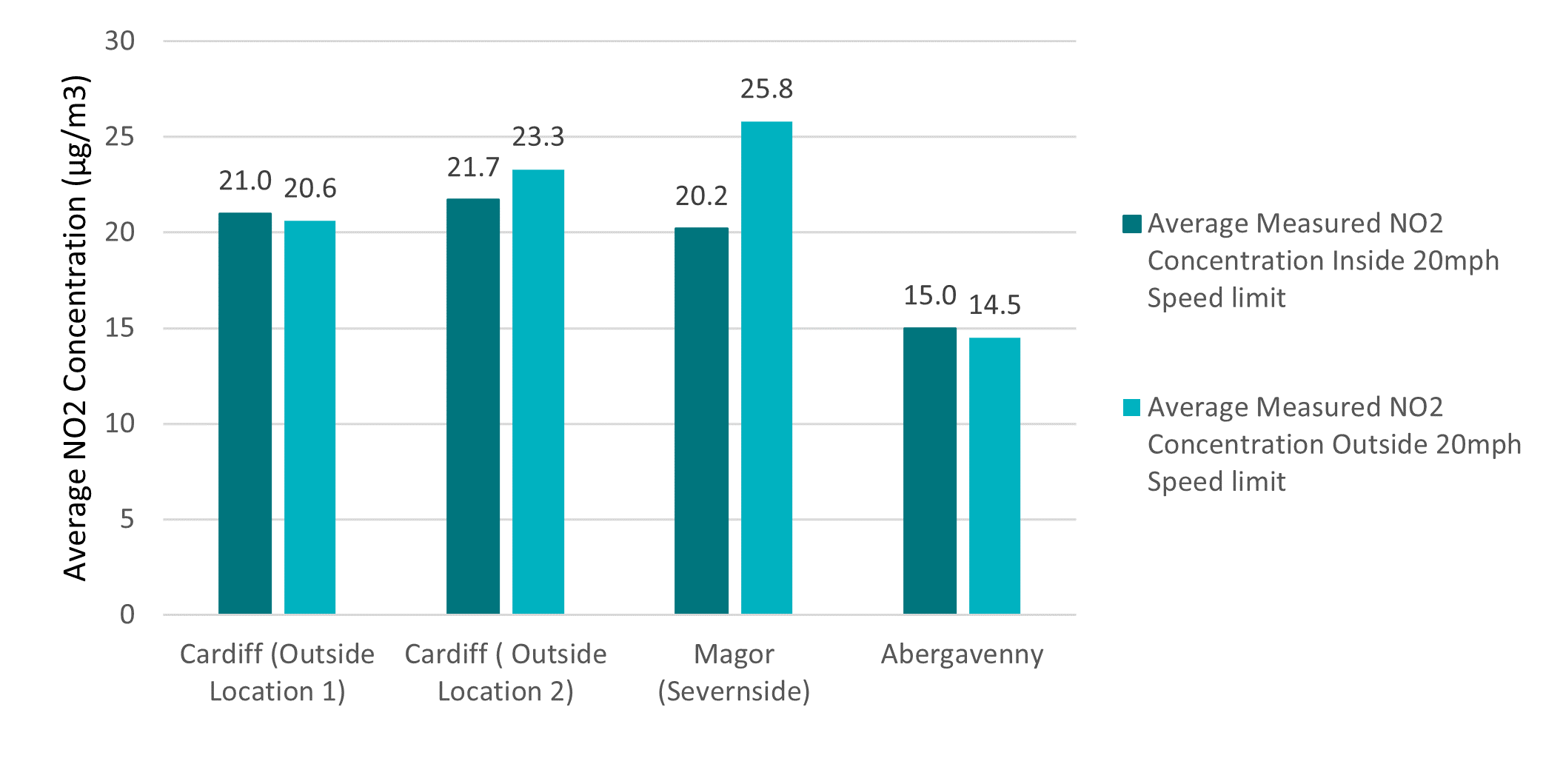 At all monitoring locations there were small differences in measured NO2 concentrations inside the 20mph speed limit area compared to outside the 20mph speed limit area. These were:
At all monitoring locations there were small differences in measured NO2 concentrations inside the 20mph speed limit area compared to outside the 20mph speed limit area. These were:
- At Cardiff (Outside Location 2) and Magor, measured NO2 concentrations inside the 20mph speed limit were lower than those outside the 20mph speed limit.
- At Cardiff (Outside Location 1) and Abergavenny, measured NO2 concentrations inside the 20mph speed limit were slightly higher than those outside the 20mph speed limit, but well within the range of measurement error.
The recorded air quality differences were small and within the average measurement error of the sensors at all locations apart from Magor.
The air quality variations can potentially be explained by other site-specific factors and circumstances causing differences in traffic volumes or acceleration activity, which could influence road traffic emissions more than slight changes in vehicle speed. These factors include nearby construction works and associated traffic management, nearby temporary road closures and proximity to vegetation. These factors are explained in detail in the Phase 1 Air Quality Monitoring Report.¹⁵
¹⁵ Published in May 2024 at https://tfw.wales/about-us/transparency/publications/default-20mph-speed-limit
4. Summary
Table 13: KPI assessment summary (as of April 2024)
| KPI |
KPI description |
Assessment | Effect¹⁶ |
|---|---|---|---|
| 1.1 | Percentage travelling at or below 24mph (as a proxy for compliance with the 20mph speed limit) | Increase from 20% to 58% travelling at or below 24mph |
Strongly positive |
| 1.2 | Change in 85th percentile speed | 3.9mph reduction in speed |
Strongly positive |
| 1.3 | Change in mean speed | 4.3mph reduction in speed |
Strongly positive |
| 1.4 | Vehicle journey times and journey time variability, based on the difference between the 5th and 95th percentile journey times as a proxy for journey time reliability, on main through routes |
Marginal increase in average journey times. Marginal decrease in journey time variability (i.e. there is improved journey time reliability) |
Slightly negative Slightly positive |
| 3.2 | Change in vehicle and pedestrian yielding behaviours | Inconclusive, as the changes in yielding behaviours varied between the sites assessed. |
No discernible change |
| 4.1 | Change in local air quality - NO2 | No material effect identified |
No discernible change |
¹⁶ Where a change is described as a positive effect this is understood in the sense that the result is aligned to the objectives of the new 20mph default speed limit on restricted roads.
Annex A: Locations for speed monitoring
Annex B: Journey time monitoring routes
Annex C: Additional information
Table 14: Timescales and source locations for monitoring data
|
KPI |
Areas / sites / routes | Time period | Notes |
|---|---|---|---|
|
1.1: Traffic compliance with 20mph speed limit 1.2: Change in 85th percentile speed 1.3: Change in mean speed |
Lampeter, Penrhyn Bay, Llanrug, Allt-yr-yn (Newport), Pembroke Dock, Newtown, Tylorstown/Pontygwaith, Torfaen (Cwmbran, Pontypool and Blaenavon), Wrexham, Peniel |
July - September 2023 (pre-implementation) November 2023 - January 2024 (post-implementation) |
These 10 areas were not analysed for phase 1 and are new for the national monitoring programme |
|
1.4: Vehicle journey times and journey time variation on main through routes |
|
February - April 2023 (pre-implementation) February - April 2024 (post-implementation) |
These routes were not analysed for phase 1 and are new for the national monitoring programme. |
|
3.2: Change in vehicle and pedestrian yielding behaviours |
King Street, Abergavenny |
February - March 2023 (pre-implementation) February - March 2024 (post-implementation) |
All sites were analysed in phase 1. Three sites marked * are being analysed for the national monitoring programme. |
|
4.1: Change in local air quality - NO2 |
Cardiff (North) |
May 2022 - April 2024 | These sites were analysed in phase 1 |
Table 15: Journey times and journey time variability
|
|
Route | AM/PM | Journey time (pre-implementation) | Journey time (post-implementation) | Change (mm:ss) | Change (%) | Journey time variability (pre-implementation) | Journey time variability (post-implementation) | Change (mm:ss) | Change (%) |
| 1 | Aberystwyth to Cardigan | AM | 01:04:35 | 01:07:33 | +02:58 | 5% | 00:09:10 | 00:07:46 | -01:24 | -15% |
| PM | 01:04:30 | 01:06:55 | +02:26 | 4% | 00:06:34 | 00:06:43 | +00:09 | 2% | ||
| Cardigan to Aberystwyth | AM | 01:04:24 | 01:06:50 | +02:26 | 4% | 00:07:38 | 00:06:46 | -00:52 | -11% | |
| PM | 01:04:13 | 01:07:13 | +03:00 | 5% | 00:07:30 | 00:06:40 | -00:50 | -11% | ||
| 2 | Llandudno to Betws-y-coed | AM | 00:29:28 | 00:31:06 | +01:37 | 6% | 00:04:11 | 00:03:38 | -00:33 | -13% |
| PM | 00:29:51 | 00:31:12 | +01:21 | 5% | 00:03:51 | 00:03:38 | -00:13 | -6% | ||
| Betws-y-coed to Llandudno | AM | 00:31:54 | 00:32:16 | +00:22 | 1% | 00:07:19 | 00:04:44 | -02:35 | -35% | |
| PM | 00:31:52 | 00:32:40 | +00:48 | 2% | 00:04:58 | 00:03:36 | -01:23 | -28% | ||
| 3 | Carmarthen to Coleg Sir Gar | AM | 00:28:55 | 00:30:36 | +01:41 | 6% | 00:03:53 | 00:04:28 | +00:35 | 15% |
| PM | 00:28:48 | 00:31:05 | +02:17 | 8% | 00:03:21 | 00:04:06 | +00:44 | 22% | ||
| Coleg Sir Gar to Carmarthen | AM | 00:28:55 | 00:31:38 | +02:43 | 9% | 00:03:01 | 00:04:37 | +01:36 | 53% | |
| PM | 00:28:52 | 00:30:57 | +02:05 | 7% | 00:02:42 | 00:04:00 | +01:18 | 48% | ||
| 4 | Porthmadog to Caernarfon | AM | 00:29:32 | 00:30:21 | +00:49 | 3% | 00:04:00 | 00:03:27 | -00:33 | -14% |
| PM | 00:30:06 | 00:30:27 | +00:21 | 1% | 00:07:35 | 00:04:07 | -03:28 | -46% | ||
| Caernarfon to Porthmadog | AM | 00:29:58 | 00:31:26 | +01:28 | 5% | 00:04:11 | 00:04:02 | -00:09 | -4% | |
| PM | 00:30:14 | 00:30:51 | +00:37 | 2% | 00:06:01 | 00:03:43 | -02:18 | -38% | ||
| 5 | Caerphilly to Newport | AM | 00:27:07 | 00:29:21 | +02:14 | 8% | 00:07:51 | 00:06:10 | -01:42 | -22% |
| PM | 00:26:50 | 00:28:25 | +01:34 | 6% | 00:05:21 | 00:03:06 | -02:14 | -42% | ||
| Newport to Caerphilly | AM | 00:25:36 | 00:27:45 | +02:09 | 8% | 00:05:01 | 00:04:54 | -00:07 | -2% | |
| PM | 00:28:58 | 00:29:18 | +00:20 | 1% | 00:10:28 | 00:05:25 | -05:03 | -48% | ||
| 6 | Wrexham to Deeside | AM | 00:27:10 | 00:28:03 | +00:53 | 3% | 00:09:33 | 00:04:57 | -04:36 | -48% |
| PM | 00:27:38 | 00:28:39 | +01:01 | 4% | 00:07:13 | 00:04:45 | -02:28 | -34% | ||
| Deeside to Wrexham | AM | 00:28:42 | 00:29:01 | +00:19 | 1% | 00:11:12 | 00:05:36 | -05:36 | -50% | |
| PM | 00:28:28 | 00:28:53 | +00:26 | 2% | 00:07:21 | 00:04:04 | -03:17 | -45% | ||
| 7 | St Davids to Haverfordwest | AM | 00:27:22 | 00:27:41 | +00:20 | 1% | 00:05:07 | 00:05:09 | +00:02 | 1% |
| PM | 00:27:41 | 00:27:41 | 00:00 | 0% | 00:04:32 | 00:04:38 | +00:06 | 2% | ||
| Haverfordwest to St Davids | AM | 00:27:33 | 00:28:14 | +00:41 | 2% | 00:04:32 | 00:04:18 | -00:14 | -5% | |
| PM | 00:27:34 | 00:27:36 | +00:02 | 0% | 00:04:34 | 00:04:00 | -00:35 | -13% | ||
| 8 | Ystrad Mynach to Crosskeys | AM | 00:17:07 | 00:18:32 | +01:25 | 8% | 00:04:12 | 00:03:16 | -00:55 | -22% |
| PM | 00:17:12 | 00:18:33 | +01:21 | 8% | 00:03:20 | 00:03:07 | -00:13 | -6% | ||
| Crosskeys to Ystrad Mynach | AM | 00:18:10 | 00:19:13 | +01:02 | 6% | 00:06:17 | 00:04:42 | -01:35 | -25% | |
| PM | 00:18:27 | 00:19:32 | +01:04 | 6% | 00:05:10 | 00:04:14 | -00:56 | -18% | ||
| 9 | Sketty to Morriston Hospital | AM | 00:17:01 | 00:17:04 | +00:03 | 0% | 00:06:22 | 00:03:46 | -02:36 | -41% |
| PM | 00:18:19 | 00:17:42 | -00:37 | -3% | 00:05:30 | 00:02:53 | -02:37 | -48% | ||
| Morriston Hospital to Sketty | AM | 00:18:19 | 00:17:42 | -00:37 | -3% | 00:05:30 | 00:02:53 | -02:37 | -48% | |
| PM | 00:18:23 | 00:17:35 | -00:47 | -4% | 00:05:42 | 00:03:50 | -01:53 | -33% | ||
| 10 | Pontypool to Blaenavon | AM | 00:14:00 | 00:15:09 | +01:09 | 8% | 00:02:37 | 00:03:27 | +00:50 | 32% |
| PM | 00:14:57 | 00:15:59 | +01:02 | 7% | 00:03:44 | 00:03:33 | -00:12 | -5% | ||
| Blaenavon to Pontypool | AM | 00:14:29 | 00:16:00 | +01:31 | 10% | 00:05:50 | 00:05:26 | -00:23 | -7% | |
| PM | 00:12:48 | 00:14:02 | +01:14 | 10% | 00:01:57 | 00:02:39 | +00:42 | 36% | ||
| 11 | Bangor-on-Dee to Wrexham Maelor | AM | 00:14:14 | 00:14:25 | +00:11 | 1% | 00:04:21 | 00:02:21 | -02:00 | -46% |
| PM | 00:14:31 | 00:14:42 | +00:11 | 1% | 00:03:34 | 00:02:16 | -01:18 | -37% | ||
| Wrexham Maelor to Bangor-on-Dee | AM | 00:15:17 | 00:15:24 | +00:07 | 1% | 00:03:31 | 00:02:14 | -01:17 | -37% | |
| PM | 00:15:44 | 00:15:51 | +00:07 | 1% | 00:03:32 | 00:01:58 | -01:34 | -44% | ||
| 12 | Barry Hospital to Dinas Powys | AM | 00:14:18 | 00:14:17 | -00:01 | 0% | 00:04:59 | 00:02:26 | -02:33 | -51% |
| PM | 00:13:17 | 00:13:48 | +00:32 | 4% | 00:02:25 | 00:01:32 | -00:53 | -37% | ||
| Dinas Powys to Barry Hospital | AM | 00:13:03 | 00:13:28 | +00:25 | 3% | 00:02:59 | 00:01:48 | -01:11 | -40% | |
| PM | 00:13:55 | 00:14:24 | +00:28 | 3% | 00:04:12 | 00:03:08 | -01:04 | -25% | ||
| 13 | St Asaph to Denbigh | AM | 00:12:33 | 00:13:10 | +00:36 | 5% | 00:03:31 | 00:02:46 | -00:45 | -21% |
| PM | 00:12:30 | 00:13:01 | +00:31 | 4% | 00:02:28 | 00:01:58 | -00:30 | -20% | ||
| Denbigh to St Asaph | AM | 00:13:02 | 00:13:35 | +00:32 | 4% | 00:03:14 | 00:02:17 | -00:57 | -29% | |
| PM | 00:12:48 | 00:13:29 | +00:41 | 5% | 00:02:25 | 00:01:59 | -00:26 | -18% | ||
| 14 | Treforest to Nantgarw | AM | 00:12:04 | 00:12:59 | +00:55 | 8% | 00:04:06 | 00:04:20 | +00:14 | 6% |
| PM | 00:13:47 | 00:12:58 | -00:50 | -6% | 00:06:08 | 00:03:32 | -02:36 | -42% | ||
| Nantgarw to Treforest | AM | 00:10:01 | 00:10:39 | +00:38 | 6% | 00:02:01 | 00:01:35 | -00:26 | -22% | |
| PM | 00:11:12 | 00:11:06 | -00:06 | -1% | 00:03:43 | 00:02:04 | -01:39 | -44% | ||
| 15 | Coedpoeth to Wrexham Maelor | AM | 00:08:20 | 00:08:52 | +00:32 | 6% | 00:03:40 | 00:03:07 | -00:33 | -15% |
| PM | 00:07:50 | 00:08:25 | +00:35 | 7% | 00:01:56 | 00:01:39 | -00:17 | -14% | ||
| Wrexham Maelor to Coedpoeth | AM | 00:07:53 | 00:08:26 | +00:33 | 7% | 00:02:09 | 00:01:40 | -00:29 | -22% | |
| PM | 00:08:46 | 00:09:07 | +00:21 | 4% | 00:03:04 | 00:01:59 | -01:05 | -35% |


